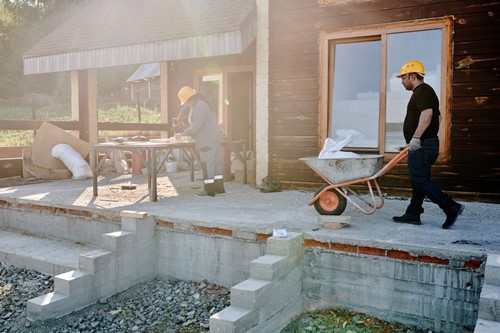
In both existing homes and new construction, there are several common types of foundations for houses. Each has their advantages and disadvantages, including specific maintenance requirements and climate-specific considerations.
Whether you’re building a new home or want to learn more about how to care for your existing home, it’s worth exploring the three major types of foundations used for houses:
Basement foundations are essentially holes dug beneath the house, matching most or all of the ground-level square footage. Builders use concrete footings around the edge of the basement space as a frame for the foundation, then follow with beams, walls and a concrete slab at the bottom.
Basement foundations can add extra living space to the home, potentially doubling the square footage if finished. Otherwise, unfinished basements serve as valuable storage space and shelter in case of extreme weather.
Concrete slab foundations are made of a simple, flat layer of concrete situated slightly below the surface of the ground. This is one of the simplest foundation types to install, involving a wire mesh and reinforcing bars within the concrete for extra stability.
Slab foundations are best for warmer regions, as frozen ground can cause cracks and shifts in the concrete. However, in the right conditions, a slab foundation will not develop weak spots or crumble over time.
Crawl space foundations have characteristics of both a basement and a slab foundation. They’re built using small concrete footings called stem walls, which create a slightly elevated space beneath the home. While you can’t use a crawl space as living space, it can be perfect for storage and access to plumbing or electrical wiring.
Crawl space foundations can help keep the home safe from flood damage, earthquake damage and termites. One disadvantage of this foundation type is the vulnerability to mold, mildew and pests who might like to make the shelter their home.
There are other types of foundations, like wood foundations and pier foundations, which are typically more specific to certain regions and types of home. There are also variations of the foundations found in this article, such as slab on grade foundations and daylight basements.
Regardless, the more you know about these three common types of concrete foundation, the more prepared you’ll be to take care of your own - whether in your current home or brand-new construction.

With over 18 years of experience, Jessica is licensed New Hampshire and Massachusetts. A proud member of the National Association of Realtors, Jessica values the highest code of ethics and standards expected of her. As a seller’s agent, she uses the most current market information to properly value the property. In addition, with her experience she is able to assist sellers on the best ways to improve homes so they can solicit the highest offers. Jessica works with a cutting edge marketing & social networking firm to obtain the maximum exposure for all of her listings. Known for her negotiating skills, she has a passion for working with buyers providing knowledge of what to expect & peace of mind throughout the process. In addition to what Jessica provides as a buyers agent, she works closely with a team of experts so it’s a “one stop shop” for all her buyers. In addition to her real estate career, Jessica is also a licensed loan originator in N.H. Combined with her expertise in both real estate, mortgages and finance, Jessica has a full understanding on the home buying and selling process. In today's real estate market it is so important for sellers and buyers to work with an agent who has great skill set and experience.